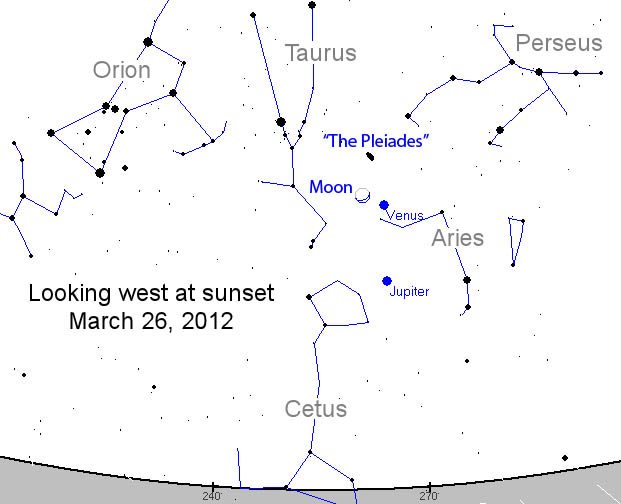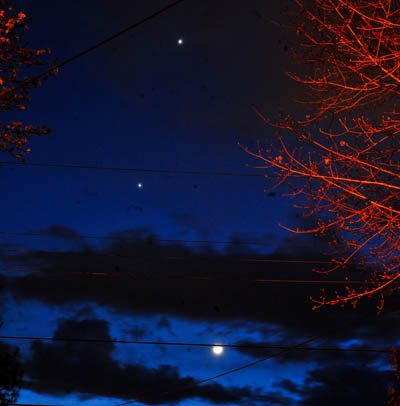Break out those tripods, the weather is nice and the sky is putting on a show. If you are the type who has to have a photo of everything (and you know who you are) you can take pictures of the night sky with an average camera — and a little thought to technique.
Sure, it helps to have a crazy long lens or shoot through a telescope. It is nice to have a motorized tripod, which allows you to follow one star and take long exposures. Hey, it would be nice to own your own island too, right?
But, I suspect most of us are more on the level of going up the parkway, finding a dark place and watching the show, at least I am. So let us stick to reality on this one.
I am assuming a basic understanding of photography terms and items here.
First, find what you want to shoot. Tonight’s sky offers several really bright items close together, that makes it more interesting than normal. Take a look at this sky map.
 |
| If you can find the moon in the evening sky, you should see the other objects easily with your eyes. |
From EarthSky.org,
After sunset today (March 26, 2012), watch for the waxing crescent moon – a thicker crescent tonight than last night – near the dazzling planet Venus in the west. You can’t miss them, because Venus is the brightest object in the sky after the sun and moon. Plus Venus is only one day away from its greatest elongation – its greatest distance from the sun on our sky’s dome. And there’s more. The planet Jupiter, the fourth-brightest celestial object in all the heavens, beams below Venus and the moon. The celebrated Pleiades star cluster glimmers a short hop above. Amazing view! Don’t miss it.
Now, let’s take a look at what that might look like through a 50mm lens. I used a tripod and exposed for 8 seconds at f11 with an ISO of 1600 for this. I like to use ASA1600 for sky photos, but not all cameras can keep the colors right at that speed. Experiment with your camera to see what works.
TIPS: Get a tripod and make sure it is stable. Mount your camera on it securely, and don’t trip on it while the shutter is open. Set your camera to Manual (if it has it) and experiment with ISO’s and shutter lengths to see what works best for you.
 |
| This was a quick grab shot from two nights ago. Tonight’s show should be cloudless with the celestial bodies closer together. I hope to do better tonight. Photo by Bill Rhodes |
<>



Before you comment
The comments section is here to provide a platform for civil dialogue on the issues we face together as a local community. Xpress is committed to offering this platform for all voices, but when the tone of the discussion gets nasty or strays off topic, we believe many people choose not to participate. Xpress editors are determined to moderate comments to ensure a constructive interchange is maintained. All comments judged not to be in keeping with the spirit of civil discourse will be removed and repeat violators will be banned. See here for our terms of service. Thank you for being part of this effort to promote respectful discussion.